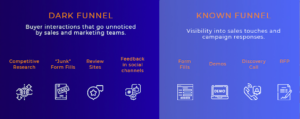B2B buying has become increasingly complex. Gone are the days when a buyer sat across from sales rep to get the information they needed. Today, buyers rely on digital channels to perform research and make decisions – BEFORE ever reaching out to a sales rep. These buyers expect a personalized experience much like that of a B2C experience. And, this requires marketing to be prepared to create messaging that’s empathetic to a buyer’s role, pain points, and business goals.
What has also changed is the definition of a lead – which ones are good leads versus those that are bad leads? In many circumstances, a lead may identify himself on a website all ready having done his research and ready to buy. But where did they come from? What information helped them along the way while evading the tracking of the sales and marketing team?
Enter the “dark funnel”.
What is a Dark Funnel?
The concept of a “dark funnel” emerged around 2016 as the traditional customer journey began to change. Potential customers began to consume information in non-traditional channels such as social media, through reputation tools and lists, and comparative studies. They became unknown to sales and marketing teams until they were ready to self-identify via form fills or registrations, known IP addresses, or download requests.

In one Forrester investigation, it was reported that “today B2B buyers will find three pieces of content about a vendor for every one piece that marketing can publish or sales can deliver”.
And at the same time, marketing teams began to report losses in the number of prospects they could generate, engagement with websites was decreasing – and when when a buyer did hit the website, they were already informed and ready to buy.
The dark funnel is replacing the traditional sales funnel. In this new normal, potential clients are well informed on the brand’s value proposition long before the prospect is identified by the marketing stack.
Complicating the buyer’s journey even further, a typical buying group for a complex B2B solution now involves six to ten decision makers, each armed with four or five pieces they have gathered independently, according to Gartner. Each of these information sources must be de-conflicted by the group before they are ready to purchase.
Enabling the New Buyer Journey
To win in this new buying environment, brands should focus on providing potential customers with information that helps them complete their research.
Gartner identified six B2B buying “jobs” that customers must complete to their satisfaction in order to successfully finalize a purchase:
-
Problem identification. “We need to do something.”
-
Solution exploration. “What’s out there to solve our problem?”
-
Requirements building. “What exactly do we need the purchase to do?”
-
Supplier selection. “Does this do what we want it to do?”
-
Validation. “We think we know the right answer, but we need to be sure.”
- Consensus creation. “We need to get everyone on board.”
The New Norm for Marketing
So if these prospects are doing research on the various brands ahead of engaging, how should a marketer approach the dark funnel?
Those sources of information are likely to be both online and offline. And, they are a made up from a variety of channels, including:
-
Your main website
-
Reputation tools
-
Competitive research
-
Influenced by previous purchases, reviews, or comparative data
-
Social listening
-
Product research — whether online or through word of mouth
-
SEO
- In-person and virtual events
Capturing these leads is no longer as simple as producing an eBook or other lead magnet, pushing the reader to a landing page, assigning them a score from within your pipeline.
The goal for marketing is to reduce friction in providing various content to the dark funnel. Some ways to do that include:
- Make content easy to find and consume. Post un-gated content in your knowledge and resource centers. Provide educational information in blogs, podcasts, and videos. Understand which content is being consumed and from which channels. Make sure content addresses concerns at all levels of the sales funnel (top, middle, and bottom of the funnel). Focus on digital access, on-demand, and self-service.
- Make use of social channels like LinkedIn, Twitter and YouTube. Buyers can find information about solutions almost anywhere – and they will. They talk to peers, industry experts, and various provider representatives to get specific questions answered. Connect with potential buyers on within these channels and build relationships. Provide educational content to build trust.
- Get listed on sites like G2, Capterra, Clutch.co, TrustRadius and others. Make it easy for potential clients to find you and compare your solutions to others in your category.
- Automate appointment setting. When a client is ready to talk to your brand or schedule a demo, make it easy for them to schedule a time to chat from your website without having to wait for someone to receive a form and contact them back. Tools like Calendly make it easy to coordinate calendars on-the-spot. And if you are able to offer a self-service, on-demand demo, conversions are even higher.
All is Not Lost
The dark funnel doesn’t have to be a problem for marketers. Focusing on the deeper insights as to what they buyer is looking for and creating a frictionless experience can add up to a better payback on marketing dollars. And, create a positive experience for prospects.
Share This Post
Latest Blog
Dark Funnel is the New Buyer’s Journey
B2B buying has become increasingly complex. Gone are the days when a buyer sat ...
How Storytelling Can Change Your Content Marketing
Storytelling is an art. It has been an intrinsic part of what makes us human. ...
All You Need to Know About Brand Strategy
It takes an average of 10 seconds for consumers to form an opinion of ...
8 Things About Digital Marketing You May Not Know
The focus of any new business is to attract as many prospects as possible ...







